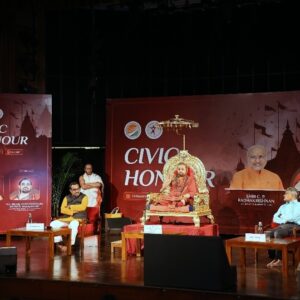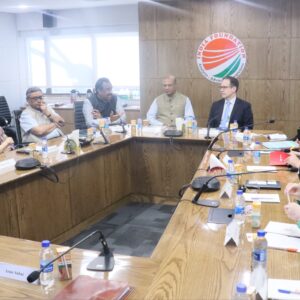The Statue of Unity will inspire generations to come about the values of integrity, patriotism, honesty and good governance.
The political trajectory of the post independence era politics in India has mostly revolved around Gandhi-Nehru dynasty. The ideological and political legacy of national movement was also built around certain personalities belittling the contribution of others like Patel, Shastri and Subhash. Over the years, this school of thought neglected the ‘collective contribution’ of many leaders for the formation of modern India, at the cost of personifying Nehru. Given the context, the inauguration of ‘Statue of Unity’ on 31st October, 2018 in the memory of great freedom fighter and national leader Sardar Vallabh Bhai patel, who was born in small village of Nadiad in Gujarat, by Prime Minister Narendra Modi is the ‘most befitting tribute’ to the Iron man of India whose legacy continues to inspire many of the later generations in India. His contribution for the freedom struggle of India stands unparalleled. In true sense he was one of the leading ‘mass leaders’ in modern India who played his role’ as a ‘savior, builder and unifier’ of India post independence. It was the ‘political statesmanship’ and devotion to the motherland of Sardar Patel that brought up the ‘political unification of India’ post independence in the times of fragile political environment, clash of competing interests and communal disharmony.
Beginning from his early days of political activism to becoming deputy Prime Minister of India, Sardar always was a ‘potent force’ of resistance against injustices and worked for the interest of masses. His boldness and confidence of the character can be attributed to one example from his childhood when he opted for Gujarati language over Sanskrit and was scolded by the teacher to which he replied gently that, “If everyone will choose to learn Sanskrit then we will have no work”. Carrying a humble background, he used to travel long distances to attend schools in Nadiad, Petlad and Borsad in Gujarat during his childhood.
His respect for duty and adherence to the principle of ‘work as worship’ can be understood from one example when Sardar choose to put the urgent telegram of his wife’s demise in his pocket after reading it during court proceedings, only to open it again when he had finished his submission and argument before the judge. Whether ‘personal or political’ troubles never discouraged him and with his iron will and greater determination, he completed whatever task he had under taken.
Beginning his political career as an elected Councilor in Ahmedabad Municipal Corporation, Patel championed the cause of ‘gender equality’, was instrumental in removing the provisions related to non-qualification of women’s to contest local body elections in Gujarat. The Ahmedabad municipality general board passed a resolution to this effect on February 13, 1913 upholding right to contest for all in local bodies.
As a great ‘savior of India’, it was Patel who had made it clear to the British authorities that the proposed Cabinet Mission Plan (1946) which puts forward the proposal of three way categorization of Indian states into A, B and C is more worse than formation of separate Pakistan and cannot be accepted.
Similarly, the partition of India and formation of Pakistan, which was implied in Atlee’s statement of 20 February 1947, was immediately countered by the Patel through his proposal demanding for a division of Punjab and Bengal, and thereby saving Assam for India before the formation of boundary commission. He knew well the demography of these states and was well intended and timely in his efforts to save this Hindu majority landmass areas for India.
As a great ‘builder of modern India’, it was Patel who stood firmly with a sense of political realism and statesmanship to protect the unity of India against the 560 odd rulers of different principalities who were nursing their own ambitions of becoming independent rulers. Through his sheer boldness and diplomatic manoeuvring, Patel secured accession of all states to India. His willingness for use of force to build united India, made possible the solution of challenges being offered by sates like Travancore, Hyderabad, Junagadh, Jamnagar, and Jodhpur. The political crisis of Hyderabad needed an iron man with a great vision and Patel most befittingly finished his work to the service of motherland.
As a great ‘unifier of modern India’ he was man of decisive leadership, immense courage and political will, and with the abilities to take forward and execute its action in the larger national interest. Had the accession of Kashmir remained out of the Nehru’s fold, Patel would have certainly able to manage its more acceptable and consensual integration with Indian state despite immediate challenges.
As a great organizer and leader, his contribution to the nation remains excellent and unsurpassable. A great disciple of Mahatma Gandhi he was the strong force behind all his satyagrahas. In one of his speech on his way to Dandi, Gandhi admitted: “I could succeed in Kheda (1918) on account of Vallabhbhai, and it is on account of him that I am here today.” After he successfully led the Bardoli satyagraha, then Times of India wrote that Patel had “instituted there a Bolshevik regime in which he plays the role of Lenin”. He played a ‘key role’ in the formation of interim government in 1946, and was central player to the smooth transfer of power from the British rulers to India. As the first Home Minister and Deputy Prime Minister of India, Patel organised relief efforts for refugees fleeing from Punjab and Delhi and worked to restore peace post partition.
In the post-independence years, he played a very key role in the establishment of modern all India civil services in India. He was also instrumental in the formation of India Police Service (IPS) to allow better policing and security standards in our country. He realized the role of civil service in running the administration country based on institutional model of democratic governance.
Philip Mason, an English Civil Servant has described Patel as “courageous, honest and realistic and someone who can be compared to Bismarck”. The most befitting tribute to Sardar Patel was given by M. N. Roy, early Communist leaders of India, “What will happen to India when the master- builder will go, sooner or later, the way of all mortals? “.
Over the years in post independent politics of India there have been efforts to deprecate the contribution of Patel for India especially under the Nehruvian School of thought. However, under the present regime led by PM Modi there have been consistent efforts to restore the due respect and regard for all those national leaders who laid their life for the service of this nation.
Those who are critical of this statue must realize that these memorials in the name of our great leaders are visible source of civilizational and political history. These are step in right direction with no sense of revising history rather putting forward a more truthful picture about our national freedom struggle. It is an effort to appropriate the true values and principles propagated by our son of soils. It is neither a step to impose greatness on somebody nor any falsification about history. Rather recognition of Patel’s unparalleled rather lately recognized contribution to the service of nation. In addition to this, as many news reports suggest the statue is drawing huge number of tourists and revenue for the public exchequer, making it gradually a most of sought of place to be visited in India.
In no case, the inauguration of ‘Statue of Unity’, as the tallest standing sculpture in the world near his hometown, by PM Modi on his 193rd birth anniversary is the symbol of ‘true recognition and recollection’ of the ideals of unity, patriotism, honesty and good governance to which Sardar Patel stood for his whole life. In doing so, the incumbent Modi government certainly states its faith in those great ideals and values.
(Mr. Abhishek Pratap Singh holds PhD in East Asian Studies from JNU and teaches at Delhi University.)




nice to read !
such a wonderful article i have ever read.